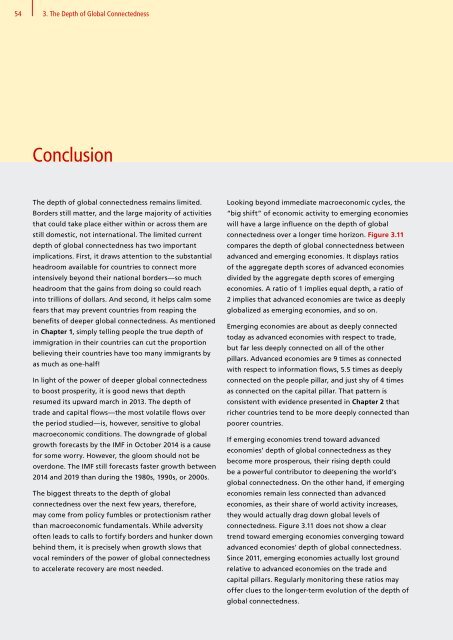DHL Global Connectedness Index 2014
DHL Global Connectedness Index 2014
DHL Global Connectedness Index 2014
- No tags were found...
You also want an ePaper? Increase the reach of your titles
YUMPU automatically turns print PDFs into web optimized ePapers that Google loves.
54 3. The Depth of <strong>Global</strong> <strong>Connectedness</strong><br />
Conclusion<br />
The depth of global connectedness remains limited.<br />
Borders still matter, and the large majority of activities<br />
that could take place either within or across them are<br />
still domestic, not international. The limited current<br />
depth of global connectedness has two important<br />
implications. First, it draws attention to the substantial<br />
headroom available for countries to connect more<br />
intensively beyond their national borders—so much<br />
headroom that the gains from doing so could reach<br />
into trillions of dollars. And second, it helps calm some<br />
fears that may prevent countries from reaping the<br />
benefits of deeper global connectedness. As mentioned<br />
in Chapter 1, simply telling people the true depth of<br />
immigration in their countries can cut the proportion<br />
believing their countries have too many immigrants by<br />
as much as one-half!<br />
In light of the power of deeper global connectedness<br />
to boost prosperity, it is good news that depth<br />
resumed its upward march in 2013. The depth of<br />
trade and capital flows—the most volatile flows over<br />
the period studied—is, however, sensitive to global<br />
macroeconomic conditions. The downgrade of global<br />
growth forecasts by the IMF in October <strong>2014</strong> is a cause<br />
for some worry. However, the gloom should not be<br />
overdone. The IMF still forecasts faster growth between<br />
<strong>2014</strong> and 2019 than during the 1980s, 1990s, or 2000s.<br />
The biggest threats to the depth of global<br />
connectedness over the next few years, therefore,<br />
may come from policy fumbles or protectionism rather<br />
than macroeconomic fundamentals. While adversity<br />
often leads to calls to fortify borders and hunker down<br />
behind them, it is precisely when growth slows that<br />
vocal reminders of the power of global connectedness<br />
to accelerate recovery are most needed.<br />
Looking beyond immediate macroeconomic cycles, the<br />
“big shift” of economic activity to emerging economies<br />
will have a large influence on the depth of global<br />
connectedness over a longer time horizon. Figure 3.11<br />
compares the depth of global connectedness between<br />
advanced and emerging economies. It displays ratios<br />
of the aggregate depth scores of advanced economies<br />
divided by the aggregate depth scores of emerging<br />
economies. A ratio of 1 implies equal depth, a ratio of<br />
2 implies that advanced economies are twice as deeply<br />
globalized as emerging economies, and so on.<br />
Emerging economies are about as deeply connected<br />
today as advanced economies with respect to trade,<br />
but far less deeply connected on all of the other<br />
pillars. Advanced economies are 9 times as connected<br />
with respect to information flows, 5.5 times as deeply<br />
connected on the people pillar, and just shy of 4 times<br />
as connected on the capital pillar. That pattern is<br />
consistent with evidence presented in Chapter 2 that<br />
richer countries tend to be more deeply connected than<br />
poorer countries.<br />
If emerging economies trend toward advanced<br />
economies’ depth of global connectedness as they<br />
become more prosperous, their rising depth could<br />
be a powerful contributor to deepening the world’s<br />
global connectedness. On the other hand, if emerging<br />
economies remain less connected than advanced<br />
economies, as their share of world activity increases,<br />
they would actually drag down global levels of<br />
connectedness. Figure 3.11 does not show a clear<br />
trend toward emerging economies converging toward<br />
advanced economies’ depth of global connectedness.<br />
Since 2011, emerging economies actually lost ground<br />
relative to advanced economies on the trade and<br />
capital pillars. Regularly monitoring these ratios may<br />
offer clues to the longer-term evolution of the depth of<br />
global connectedness.





